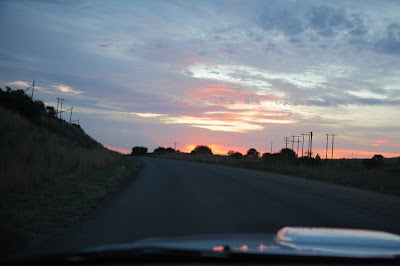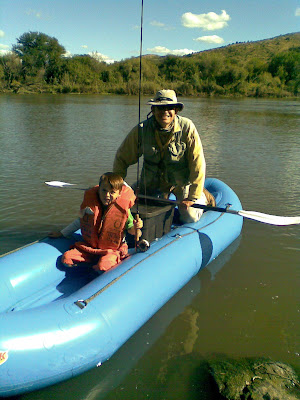
Road trips I love them (at least till we get to the water)
Can you teach an old dog new tricks? Some you can some you can’t. I discovered this on my previous fishing trip, to Sterkfontein dam. Not the middle Vaal I know but fishing for smallmouth none the less. On the Friday we arrived we had to fish on foot – with very strong winds we were forced to fish the accessible sheltered areas. The first spot produced my first largemouth in this dam on a small Zak nymph. It gave me a lovely fight and certainly got our tails up.

A fruitless 30 minutes followed and I moved to higher ground, which revealed very little in terms of fish, we moved on. Another shore access spot was completely blown out, with no fish showing!?!

One last trick up our sleeves; we had a choice of rocky shoreline and open bay with sandy/muddy bottom. The bay was wind swept but a small ridge gave enough protection to make a cast. My mates headed to the rocky shoreline, as this was completely protected, and the in the Manual of Sterkies chapter 4 states this is one of the spots.
 The Zak did duty again, the high sun afforded enough visibility in the choppy conditions for me to spot 2 fish following but refusing the fly. I immediately switched to a hopper as the water was shallow about 1-1.5m. A short cast into the wind was all I required, the hopper drifted for 2metres before a big mouth engulfed the fly. WOW! She left the shallow flats like a Tokyo bullet train, trying with all her guile to rid her of the 5X tippet holding her back. I landed and released her taking a few minutes to savour the moment – and decide on continuing fishing or go call my friends – I’m such a good person.
The Zak did duty again, the high sun afforded enough visibility in the choppy conditions for me to spot 2 fish following but refusing the fly. I immediately switched to a hopper as the water was shallow about 1-1.5m. A short cast into the wind was all I required, the hopper drifted for 2metres before a big mouth engulfed the fly. WOW! She left the shallow flats like a Tokyo bullet train, trying with all her guile to rid her of the 5X tippet holding her back. I landed and released her taking a few minutes to savour the moment – and decide on continuing fishing or go call my friends – I’m such a good person.
The area they were fishing, a top spot in high summer, was void of fish.

They joined me in the bay and Jaco promptly got his first smallie in Sterkies.

The following 2 hours I experienced some of the most amazing fly fishing for smallies I’ve had in my life. The fish were big and fat, they engulfed the hopper (no missed takes) and they all ran like a bat towards deeper water.
 Kobus did not have permission from the wife to go, he wasn’t there.
Kobus did not have permission from the wife to go, he wasn’t there.
The one lesson I got ingrained again was to find the fish – the usual spots or some completely new place. At Sterkfontein the clear water makes this easy – if the weather co-operate. The Vaal in summer can become so predictable that our cerebral development in the fly fishing lobe takes a serious knock.
This is further aggravated by fishing the same venue! There are various methods to identify the holding places of the fish on the Vaal.
· Find a bit of high ground and use it to spot the fish flashing as they feed. Even in discoloured water the tell tale flashes are visible.
· Pause to survey the river at water level, you may just notice a tail doing the “overhere” wave. This accounted for my first largemouth, a fish of 4.5kg.
· In the pools and glides, keep an eye open for dark torpedo shapes just sub-surface or the dorsal-tail fins of feeding yellows.
· If you see nothing give the fly in water technique a go, but take a break every so often to check for activity.

Only the clever survive, the stupid catch nothing.
The longer term weather predictions are for this year to be an El Nino year, which translates into low rainfall, especially early season. To date this holds true and has afforded us fairly constant flows over October. The only spike due to a canoe race held over the last weekend.
Good luck tread lightly and avoid the spawning fish!

Carl & Keith
http://yellowsonfly.blogspot.com/

 you will experience Highveld thunderstorms on most afternoons. Not much you can do about that but hunker down and make sure you do not become lightning fodder. Most of these are over within 30 minutes affording you excellent fishing for the rest of the afternoon.
you will experience Highveld thunderstorms on most afternoons. Not much you can do about that but hunker down and make sure you do not become lightning fodder. Most of these are over within 30 minutes affording you excellent fishing for the rest of the afternoon.






 Kobus did not have permission from the wife to go, he wasn’t there.
Kobus did not have permission from the wife to go, he wasn’t there.


 I read my old reports – I do – there is some good advice stored in there. But every year or season is different, nature just has some things that does not run linear. I still vividly remember 24 September in 2001 fishing a farm called Carryblaire for the first time. I met Chris the owner’s son at a wine tasting and cracked an invite to a then private venue. It was a red letter day we seriously klapped the yellows, in those days I still counted and tallied something like 50 and they were big fat wintered fish. [Nowadays I would call it a day before I get so many in a small area.] The big green rock worms were on every rock you turned over . I have never had a day like that again on all subsequent 24 Septembers.
I read my old reports – I do – there is some good advice stored in there. But every year or season is different, nature just has some things that does not run linear. I still vividly remember 24 September in 2001 fishing a farm called Carryblaire for the first time. I met Chris the owner’s son at a wine tasting and cracked an invite to a then private venue. It was a red letter day we seriously klapped the yellows, in those days I still counted and tallied something like 50 and they were big fat wintered fish. [Nowadays I would call it a day before I get so many in a small area.] The big green rock worms were on every rock you turned over . I have never had a day like that again on all subsequent 24 Septembers. 





 Barend Esterhuizen put to work the knowledge gained from fishing with a guide.
Barend Esterhuizen put to work the knowledge gained from fishing with a guide. 







